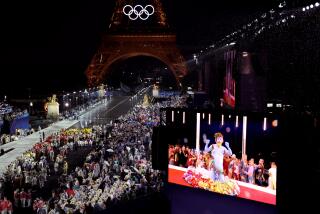France Celebrates Its Bicentennial With Tanks, Planes and Parades
- Share via
PARIS — A parade of moonwalking U.S. college students, ponies painted to look like zebras, and a Russian bear on skates lent fantasy to Friday and Saturday’s celebration of the 200th anniversary of the French Revolution.
It also offered a somber reminder of the price of liberty.
In a late change of program after last month’s repression in Beijing, hundreds of Chinese students walked bicycles around a giant red drum. They wore headbands bearing the Chinese characters for “Liberty, Equality, Fraternity,” the watchwords of the French Revolution.
Storming of Bastille
The parade, and an earlier one Friday, celebrated the July 14, 1789, storming of the Bastille.
The thousands of revolutionaries who rushed the hated prison found only seven inmates to free, locked up not for their politics but for fraud, incest and lunacy, but the action marked the beginning of the French Revolution.
In the evening parade, the 250 musicians of the Florida A&M; band, gliding backwards in a Michael Jackson moonwalk down the Champs Elysees before a crowd estimated at 1 million, offered a tribute to American soul star James Brown.
They shared the famous avenue with Scottish pipers marching in artificial rain, Soviet guards walking in fake snow, a huge steam locomotive, and other creations of the imagination of French advertising maverick Jean-Paul Goude.
The $15-million extravaganza of fantasy and symbolism was called the “The Marseillaise,” a parade described by Goude as a “slightly frivolous opera-ballet.”
Besides the lively crowds in the street, about 30 presidents and prime ministers gathered on a balcony overlooking the Place de la Concorde. They were in Paris to attend the festivities and participate in an annual summit conference of industrial nations, which began Friday.
Bush on TV
Television audiences in France and much of Europe also watched the parade, which began late Friday and extended into early Saturday.
French television showed British Prime Minister Margaret Thatcher peering through binoculars at the 6,000 performers. Viewers saw President Bush and his wife, Barbara, chatting with other guests as fireworks lit up the sky.
Temporary grandstands on the Place de la Concorde held about 16,000 other invited guests, including celebrities and officials. They also provided seating for French citizens born on July 14 or with the first name “France.”
In an emotional climax of the parade, American opera diva Jessye Norman, wrapped in the blue, white and red colors of the French flag, sang the rousing verses of the national anthem, “The Marseillaise.”
Elyiane Picard of Nice, bedecked with revolutionary tricolor buttons, held on to a few inches of standing space at the base of an iron fence along the Champs Elysees for nine hours to watch.
“The parade is something I never would have wanted to watch on television,” she said. “It’s a historic happening, and I wanted to be able to tell my children I was there.”
Pomp and Firepower
Twelve hours earlier on the same parade route, silver-helmeted Republican Guards pranced below jet fighters trailing the national colors in a display of precision, pomp and firepower. More than 250 planes and helicopters streaked down the length of the flag-bedecked avenue.
Columns of more than 5,000 men and women, from frogmen to Foreign Legionnaires, 300 armored vehicles, and unarmed mobile missiles flowed down the avenue to martial music.
President Francois Mitterrand reviewed the troops at the Place de L’Etoile. Then, standing upright in a light reconnaissance vehicle, he rode down the grand avenue to the Place de la Concorde.
Frenchmen and tourists danced through the night Thursday at balls around Paris and elsewhere in France.
“We’re here helping to celebrate what we started with our revolution and the French finished,” said James M. Young of Boston, who brought his family to France for the bicentennial.
“This grandeur, beauty, pageantry and feeling of nationality--this is what we wanted the children to capture.”
More to Read
Sign up for Essential California
The most important California stories and recommendations in your inbox every morning.
You may occasionally receive promotional content from the Los Angeles Times.













